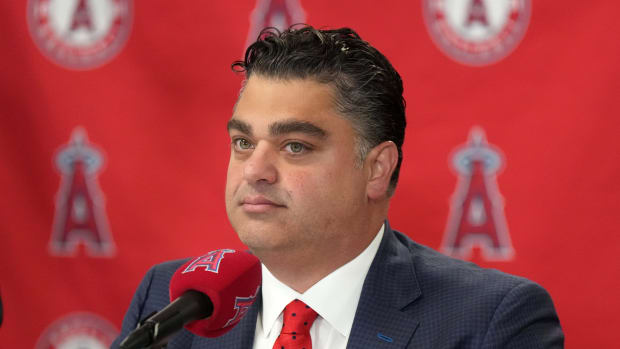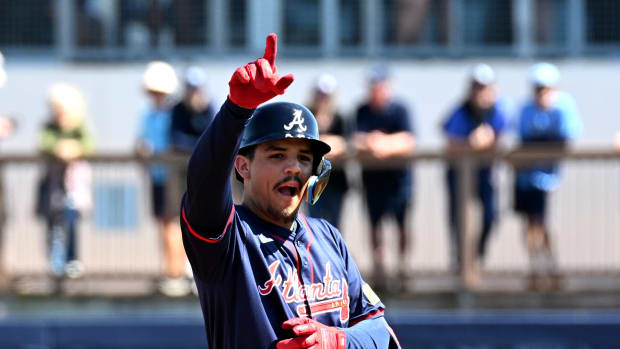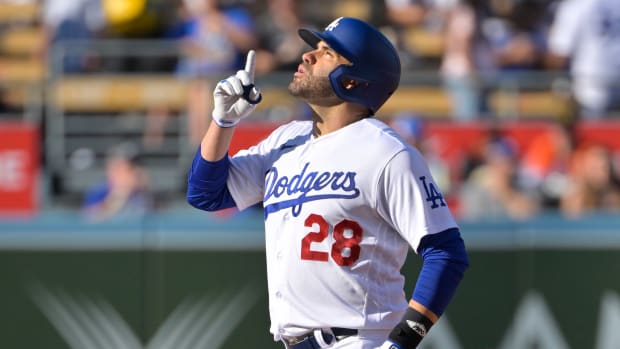Highlights and lowlights from the best WBC ever, one capped by long-awaited USA win
The enduring image of the 2017 World Baseball Classic could pass for a staged publicity shot ordered by baseball commissioner and chief WBC salesman Rob Manfred, but it really happened organically. It is the picture of Adam Jones, wearing a jersey with USA across the chest, leaping in front of a WBC logo on the centerfield wall to steal a home run from Manny Machado last Saturday night, while behind him American flags wave and fans smile and wonder in delight. What a catch—not just for Jones but also for us. Baseball in March never looked better than it did in the fourth WBC.
This is the year the WBC, better known for catching flak, caught momentum. It was the best-attended, most-watched, most profitable, most dramatic international baseball tournament ever staged, and such facts were true even before the United States, to the relief of commissioner Rob Manfred, finally won the darn thing, though its 8–0 championship victory over a red-hot Puerto Rico team Wednesday night in Los Angeles was one of the rare dull games in the tourney.
The biggest problem with the WBC has always been the spoiled, provincial American fan, full of complaint that it’s not “big-time” enough without Mike Trout, broadcast network coverage, boffo ratings or betting pools. Okay, so it’s no competition for March Madness. So would you rather have ... more dreadful spring training games populated by minor leaguers with nothing on the line?
The WBC has hit the bulls-eye on its three major goals: 1. Grow the game internationally. 2. Stimulate grassroots development. 3. Make money for the players and the owners.
Rob Manfred's stern message: MLB will modernize, no matter what players want
Listen to what Puerto Rico manager Edwin Rodriguez said Wednesday night before his team played in its second WBC final, when asked how baseball has grown in Puerto Rico with the help of the WBC: “Huge changes for the last, I would say, eight years. Ever since we started off with Carlos Correa selection in the first pick of the 2012 draft, and then after that the 2013 WBC, and then [Francisco] Lindor, [Javier] Baez and Correa, I mean, there’s more youngsters playing baseball.”
Every night you could watch All-Stars and unknowns play their hearts out for their countries with exciting, emotional and oftentimes charmingly unkempt baseball. If you like baseball even a little bit, the WBC is a gift. It’s baseball played with urgency and élan. Meanwhile, a portion of the revenues—the tournament was expected to generate more than $100 million, a record—gets funneled back to local baseball federations around the world to foster growth of the game. We’re talking about building fields and ballparks and providing instruction.
While many in America yawn or care more about the fifth-starter competition for their favorite MLB team, Japan sees nearly 30% of its TV viewers locked in to the WBC, and life nearly comes to a stop in Latin America countries when their team is playing.
There is only one thing “wrong” with the WBC: when it is played, which forces weird pitching rules and invites American players to avoid it because they argue it gets them out of their “routine.” There are two things the owners and players can do about this “problem” of timing:
1. Replace the four-day All-Star break (and the All-Star game itself) every fourth year with eight to 10 days of WBC action: two pools of four teams each in two venues, followed by an international home run derby, a doubleheader semifinal and a Sunday 6 p.m. Eastern time championship game in another venue. The top six ranked nations are in. Two teams earn their way in via qualifiers during spring training. As I wrote when the tournament began, this July idea has been discussed among MLB officials and, to a lesser degree, the players. It has support from key people. No more governors on pitchers and no more excuses from healthy players not to participate.
2. Do nothing. Leave the WBC where it is. Just accept the tournament for what it is: endearingly flawed and more important to baseball’s global brand than the domestic one, and a great run-up to the MLB season.
Attendance at the WBC passed one million for the first time. Television ratings were up 12% heading into the championship game. The first United States-Dominican Republic game (played on Saturday, March 11) drew 977,000 viewers—still not as many as a Thursday night TNT NBA games between Indiana and Charlotte, but amazing for a baseball game in March. The crowd that night in Miami drew comparisons to the most raucous ones ever heard at a World Series.
Manfred wanted to see what the WBC would look like with Team USA in the finals. He got that and, as it turned out, even more, thanks to the superb pitching of Marcus Stroman, who is 5'8" inches of determination and who heeded the call most top American pitchers ignored or mocked. Stroman took a no-hitter into the seventh inning Wednesday night and left after allowing just one hit and one walk, striking out three. The tournament was everything for which Manfred could have hoped.
Maybe the next one, in 2021, will be held in July and have the sports landscape all to itself, rather than getting crowded by college basketball. And maybe top American players will want to be a part of the excitement, as did Giants reliever Mark Melancon, who hopped aboard the WBC train this year after it already had left the station. The tournament has history now, as well as a small but important footprint on the thick calendar of major American sporting events.
The next one will be even bigger, whether baseball moves it to July or keeps it in March. It wasn’t that the USA saved the WBC by winning it for the first time. It’s that the games were so compelling and the players were so engaged that the focus switched from who wasn’t there to the purity of the action on the field.
Is it perfect? No. This is the tournament in which Canada twice gave the ball to a guy who had been retired for three years (Ryan Dempster). Puerto Rico in the final used an independent league reliever (J.C. Romero) to try to hold down a USA lineup in which the highest-paid player in baseball (Giancarlo Stanton) batted eighth and the most decorated active player (Buster Posey) sat on the bench. But such quirkiness is part of the appeal, too. It’s fun. And who doesn’t want some more fun on a baseball field?
Jones’s catch may have been the biggest highlight of the WBC, but the memorable moments were many. To review, here are the other highlights from 16 days of March Gladness, as well as the lowlights, which had their own appeal in a strange way.
Highlights
• Blondes have more fun: Supplies of blonde hair dye grew scarce in Puerto Rico as citizens were dyeing to support their baseball team, which adopted the yellow-hair look in a show of unity. In America, meanwhile, thoughts of backing the national baseball team lost out to the fervor for political protests; sales of poster boards and art supplies skyrocketed.
• Tiebreaker rule: Don’t get your undershorts in a bind. Starting the 11th inning with runners on first and second isn’t a sacrilege and it’s not coming to the majors. But the modified version of the California tiebreaker used in youth baseball worked perfectly in tournament-style baseball: it saved pitching, put an emphasis on strategy (bunts, intentional walks, pitcher-batter matchups) and brought a quick resolution to games that already were taking too long.
• Wladimir Balentien: The Netherlands’ 32-year-old slugger, who hits bombs for Japan's Yakult Swallows in his day job, was the baddest dude of the tournament. He batted .615, pounded out 16 hits—four of which were home runs—and provided the best bat flip of the tournament. Not bad for a guy who was DFA’d by the Mariners in 2009.
• Team Israel: Not only did it mount an early, surprising run, but it also replaced the Rally Plantain with the best mascot of the tournament, Mensch on the Bench.
• Colombia: Colombia came within two plays of sweeping Pool C, losing against the U.S. in part because of a dropped third strike and losing to the Dominican Republic in extra innings after leftfielder Jose Bautista threw out the potential winning run at the plate in the ninth.
• Nelson Cruz: How important are these games? Cruz, who has played in the World Series and been an ALCS MVP, said the home run he hit off Andrew Miller for the Dominican Republic to beat the USA on March 11 was the biggest home run of his career. Why? The man who has played for four major league teams said you only have one true home team: where you are from.
• Javier Baez: Whether making a no-look, celebratory tag or pulling off a Matrix-style slide at third base, Baez forced you to pay attention—and to smile.
Lowlights
• Pace of play: Dreadful. There were 40 games, and only three times did teams manage to play a nine-inning game in under three hours. The average time of game was 3:31. There were eight games that lasted more than four hours.
• Dead time: While many games had dramatic endings you often had to sit through hours of tedium to get there. The WBC desperately needs a pitch clock and a limit on timeouts. (We’re talking to you, Yadier Molina, and all the Yadier-wannabe catchers who kept trudging out to the mound.)
• Unlimited replays: After the fiasco of the three games in Los Angeles, I never want to see this again any time, anywhere.
• Pitching changes: Games averaged 11.8 pitchers per game. Some games featured 16 pitchers. Sixteen! No nine-inning game was played with fewer than eight pitchers.
2017 MLB Trade Value player rankings: Nos. 50–1
• Canada and Mexico: By finishing in last place in their respective pools, our North American neighbors are not guaranteed to take part in a fifth straight WBC. They must earn their way there through qualifiers.
• Injury alarmists: Netherlands infielder Didi Gregorius will miss the first month of the Yankees’ season because of an injury to his shoulder suffered during the WBC, leading to predictable howls about how the WBC jeopardizes players. Nonsense. Repeated research done by MLB has shown that players who participate in the WBC are no more likely to be injured than players who don’t. And by the way, where are the howls of protest about the dangers of spring training after headliners like the Dodgers' Corey Seager, the Red Sox' David Price and the Rockies' Ian Desmond, among others, have been hurt while skipping the WBC.
• Club officials and managers: They’re not all in on the WBC. They can’t stop players from participating, but they often discourage American players from playing in it. One manager confided in me, “I let my [key] pitchers know I didn’t really want them there—and they’re not.”
• The Dodgers and Rays: Los Angeles refused to allow closer Kenley Jansen to pitch a second inning after throwing just nine pitches in one inning for the Netherlands, and Tampa Bay embarrassed USA manager Jim Leyland by having Chris Archer come out of a game early, only to throw more pitches in the bullpen while the game still was going on.
• Daniel Murphy: The poor dude was chained to the USA's bench. When was the last time Murphy went two weeks without a hit? The Nationals' second baseman batted .347 last year and was the NL MVP runner-up, but when he looked bad in the WBC opener, Murphy found himself with almost no playing time as Ian Kinsler locked down second base. Murphy came to the plate only six times, and Pirates infielder Josh Harrison got only five at-bats. That’s no way to prepare for the season.
• Nolan Arenado: He is unquestionably a great hitter, but the Rockies' slugging third baseman cratered when it came to playing in the spotlight for the first time in his career. It wasn’t just that Arenado went 4-for-30; it was that he was jittery in the batter’s box. His timing and plate discipline were awful. The good news is that the experience should serve him well when Colorado does play meaningful games.
• Jurickson Profar: He provided a lesson that lives forever: what happens when showboating goes too far.





































